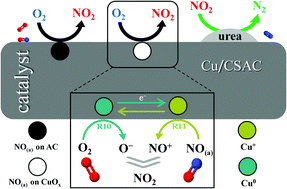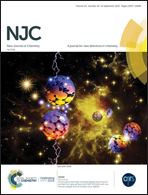Novel efficient U–Cu/CSAC catalyst for selective reduction of NO at low temperatures: preparation, characterization, evaluation and mechanism†
Abstract
Low-temperature urea-SCR (LTU-SCR) is a novel and environmentally-benign technique for selective reduction of NO in low-temperature flue gas, which could also avert the trouble of ammonia escape. In this study, the superior copper-based catalyst was synthesized using the ultrasound-assisted impregnation method and used for removing NO. The physical and chemical properties of the catalyst were researched by using elemental analysis (EA), BET analysis, field emission scanning electron microscopy (FESEM), energy dispersive spectroscopy (EDS), transmission electron microscopy (TEM), X-ray diffraction (XRD), X-ray photoelectron spectroscopy (XPS), atomic absorption spectroscopy (AAS), Fourier transform infrared spectroscopy (FT-IR), temperature programmed desorption of NO (NO-TPD) and temperature programmed desorption of O2 (O2-TPD). The catalytic performance results show that highly dispersed Cu0 nanoparticles and amorphous Cu2O supported on coconut shell-based activated carbon (Cu/CSAC) yielded nearly 100% NO conversion at low temperatures (50–100 °C). Besides, based on the thermodynamic analyses and characterization results, the NO conversion mechanism for the novel LTU-SCR on the Cu/CSAC catalyst was proposed and systematically discussed; the uniform loading of the active metal, enhancement of NO absorption by active metal oxides and electron transfer of Cu+ ⇌ Cu0 promoted the LTU-SCR process.



 Please wait while we load your content...
Please wait while we load your content...